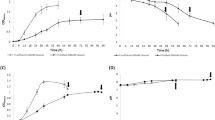Abstract
Pseudomonas is an efficient plant growth–promoting rhizobacteria; however, among the limiting factors for its commercialization, tolerance for high temperature is the most critical one. After screening 2,500 Pseudomnas sp. strains, a high temperature tolerant–strain Pseudomonas putida NBRI0987 was isolated from the drought-exposed rhizosphere of chickpea (Cicer arietinum L. cv. Radhey), which was grown under rain-fed conditions. P. putida NBRI0987 tolerated a temperature of 40°C for ≤ 5 days. To the best of our knowledge, this is the first report of a Pseudomnas sp. demonstrating survival estimated by counting viable cells under such a high temperature. P. putida NBRI0987 colony-forming unit (CFU)/ml on day 10 in both the absence and presence of MgSO4.7H2O (MgSO4) in combination with glycerol at 40°C were 0.0 and 1.7 × 1011, respectively. MgSO4 plus glycerol also enhanced the ability of P. putida NBRI0987 to tolerate high temperatures by inducing its ability to form biofilm. However, production of alginate was not critical for biofilm formation. The present study demonstrates overexpression of stress sigma factor σ S (RpoS) when P. putida NBRI0987 is grown under high-temperature stress at 40°C compared with 30°C. We present evidence, albeit indirect, that the adaptation of P. putida NBRI0987 to high temperatures is a complex multilevel regulatory process in which many different genes can be involved.



Similar content being viewed by others
References
Chatterjee A, Cui Y, Hasegawa H et al (2007) PsrA, the Pseudomonas sigma regulator, controls regulators of epiphytic fitness, quorum-sensing signals, and plant interactions in Pseudomonas syringae pv. tomato strain DC3000. Appl Environ Microbiol 73:3684–3694
Corbella ME, Puyet A (2003) Real-time reverse transcription-PCR analysis of expression of halobenzoate and salicylate catabolism-associated operons in two strains of Pseudomonas aeruginosa. Appl Environ Microbiol 69:2269–2275
Dubern JF, Lagendijk EL, Lugtenberg BJJ et al (2005) The heat shock genes dnaK, dnaJ, and grpE are involved in regulation of putisolvin biosynthesis in Pseudomonas putida PCL1445. J Bacteriol 187:5967–5976
Heeb S, Valverde C, Gigot-Bonnefoy C et al (2005) Role of the stress sigma factor RpoS in GacA/RsmA-controlled secondary metabolism and resistance to oxidative stress in Pseudomonas fluorescens CHA0. FEMS Microbiol Lett 243:251–258
Kojic M, Degrassi G, Venturi V (1999) Cloning and characterization of the rpoS gene from plant growth- promoting Pseudomonas putida WCS358: RpoS is not involved in siderophore and homoserine lactone production. Biochim Biophys Acta 1489:413–420
Nautiyal CS, Johri JK, Singh HB (2002) Survival of rhizosphere-competent biocontrol strain, Pseudomonas fluorescens NBRI2650, in the soil and phytosphere. Can J Microbiol 48:588–601
Nautiyal CS (2006) Biological control of plant diseases by natural and genetically engineered fluorescent Pseudomonas spp. In: Ray RC, Owen P Ward (eds) Microbial biotechnology in horticulture. Science Publishers, Enfield, NH, pp 125–162
Nautiyal CS, Mehta S, Singh HB (2006) Biological control and plant growth-promoting Bacillus strains from milk. J Microbiol Biotechnol 16:184–192
Nautiyal CS, DasGupta SM (2007) Screening of plant growth-promoting rhizobacteria. In: Verma A, Oelmuller R (eds) Advanced techniques in soil microbiology. Soil biology series, vol. 11. Springer Verlag, Heidelberg, Germany, pp 363–373
O’Toole GA, Kolter R (1998) Initiation of biofilm formation in Pseudomonas fluorescens WCS365 proceeds via multiple, convergent signalling pathways: A genetic analysis. Mol Microbiol 28:449–461
Rinaudi L, Fujishige NA, Hirsch AM, Banchio et al (2006) Effects of nutritional and environmental conditions on Sinorhizobium meliloti biofilm formation. Res Microbiol 157:867–875
Rodr´ıguez-Navarro DN, Dardanelli MS, Ru´ız-Sa´ın JE (2007) Attachment of bacteria to the roots of higher plants. FEMS Microbiol Lett 272:127–136
Sparkowski J, Das A (1990) The nucleotide sequence of greA, a suppressor gene that restores growth of an Escherichia coli RNA polymerase mutant at high temperature. Nucl Acid Res18:6443
Stapper AP, Narasimhan G, Ohman DE et al (2004) Alginate production affects Pseudomonas aeruginosa biofilm development and architecture but is not essential for biofilm formation. J Med Microbiol 53:679-690
Tart AH, Blanks MJ, Wozniak DJ (2006) The AlgT-dependent transcriptional regulator AmrZ (AlgZ) inhibits flagellum biosynthesis in mucoid, nonmotile Pseudomonas aeruginosa cystic fibrosis isolates. J Bacteriol 188:6483–6489
Volker U, Engelmann S, Maul BS et al (1994) Analysis of the induction of general stress proteins of Bacillus subtilis. Microbiol 140:741–752
Wozniak DJ, Timna JO, Wyckoff MS et al (2003) Alginate is not a significant component of the extracellular polysaccharide matrix of PA14 and PAO1 Pseudomonas aeruginosa biofilms. Proc Natl Acad Sci U S A 100:7907–7912
Acknowledgments
Thanks are due to the director of the National Botanical Research Institute, Lucknow, for necessary support of this study. The study was supported by Task Force Grant No. SMM-002 from the Council of Scientific and Industrial Research, New Delhi, India, awarded to C. S. N.
Author information
Authors and Affiliations
Corresponding author
Rights and permissions
About this article
Cite this article
Srivastava, S., Yadav, A., Seem, K. et al. Effect of High Temperature on Pseudomonas putida NBRI0987 Biofilm Formation and Expression of Stress Sigma Factor RpoS. Curr Microbiol 56, 453–457 (2008). https://doi.org/10.1007/s00284-008-9105-0
Received:
Accepted:
Published:
Issue Date:
DOI: https://doi.org/10.1007/s00284-008-9105-0




